
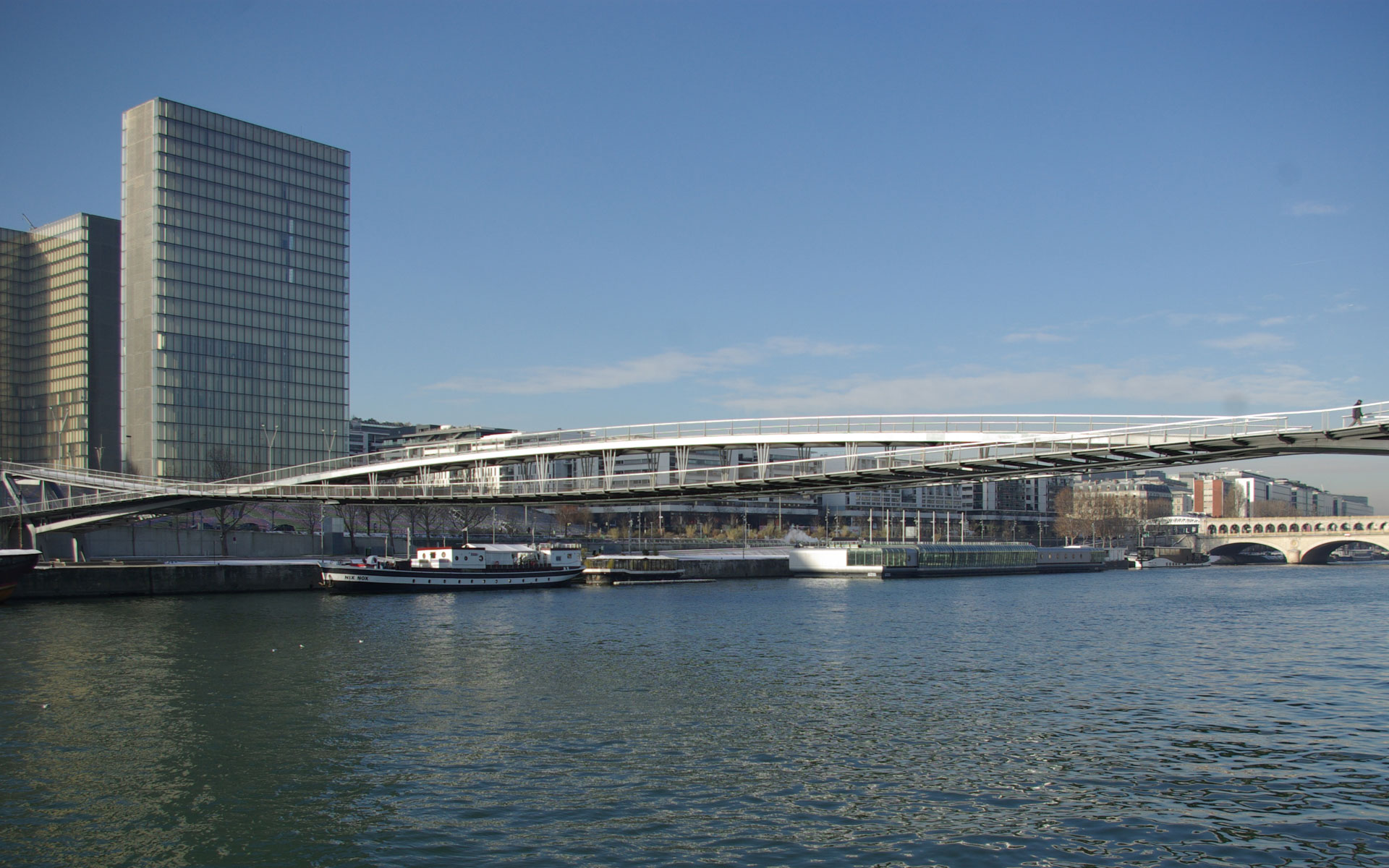
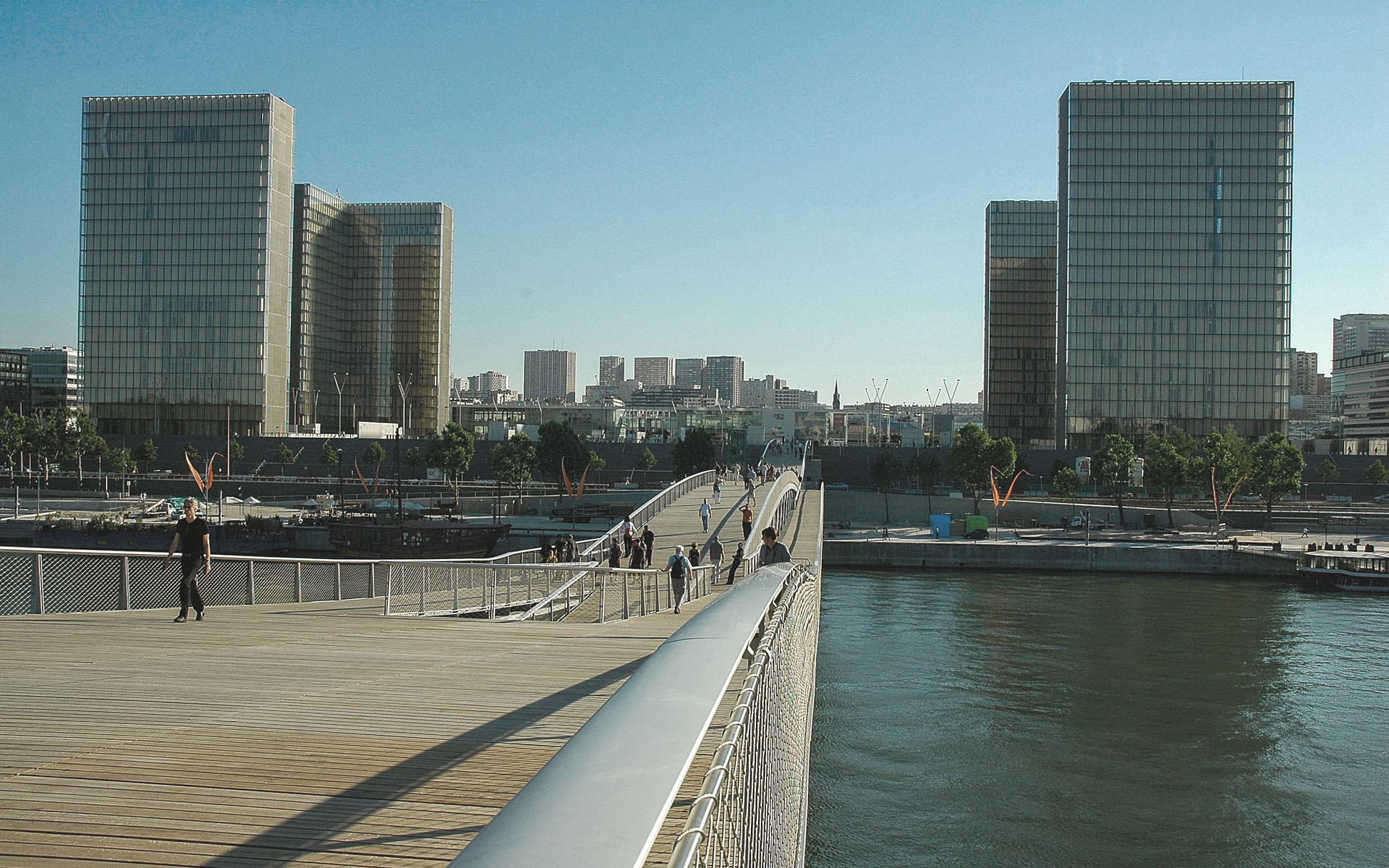










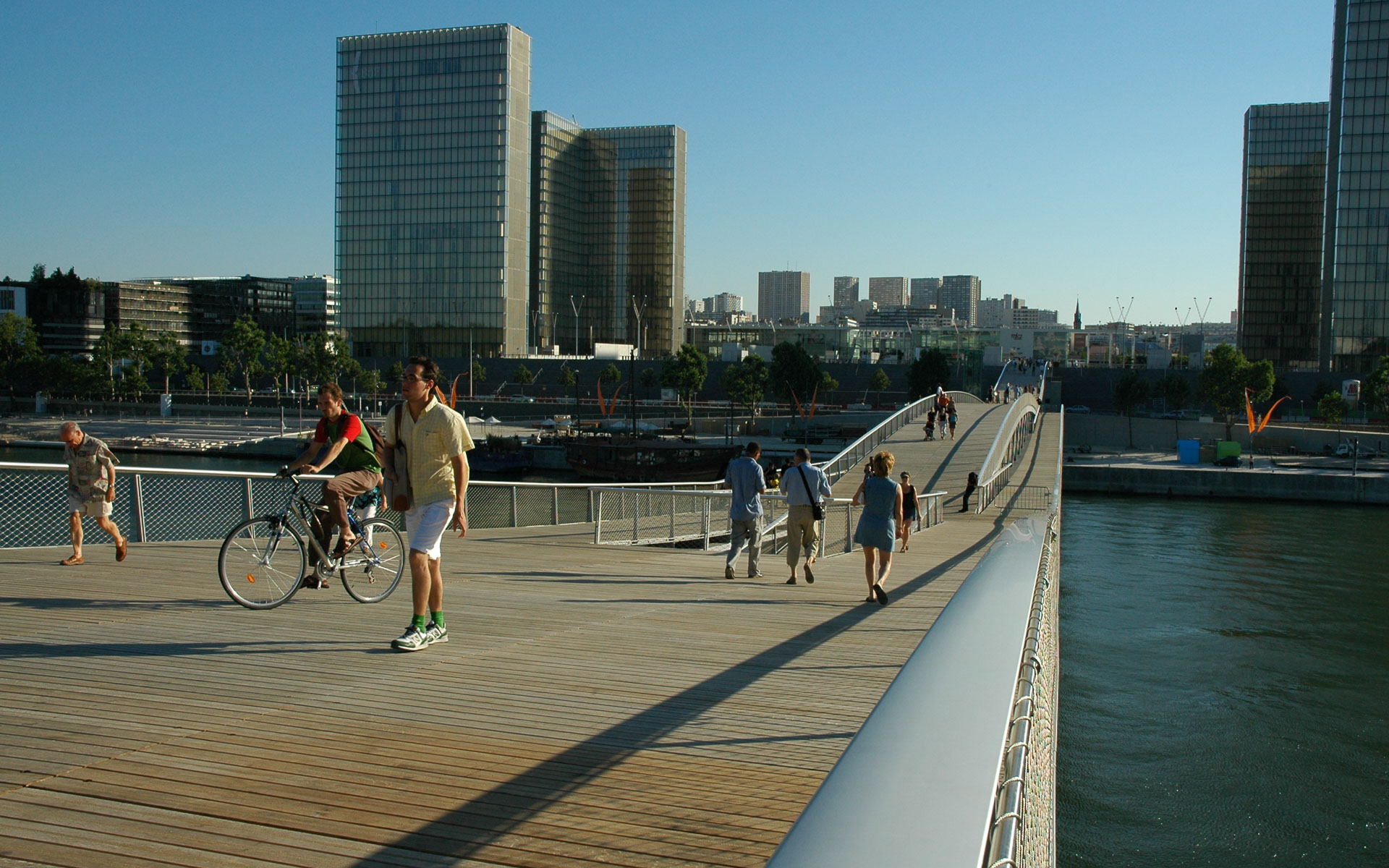














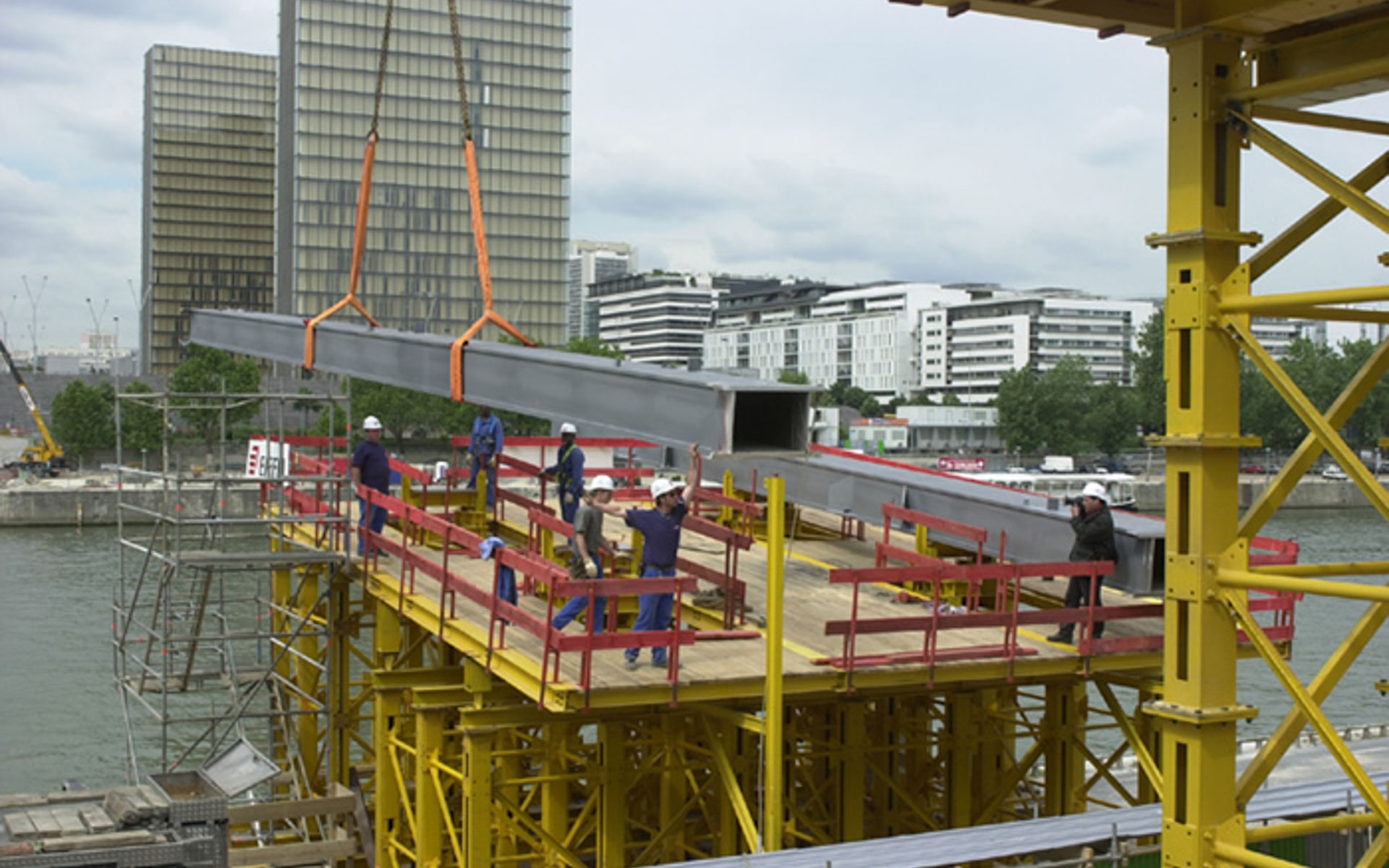



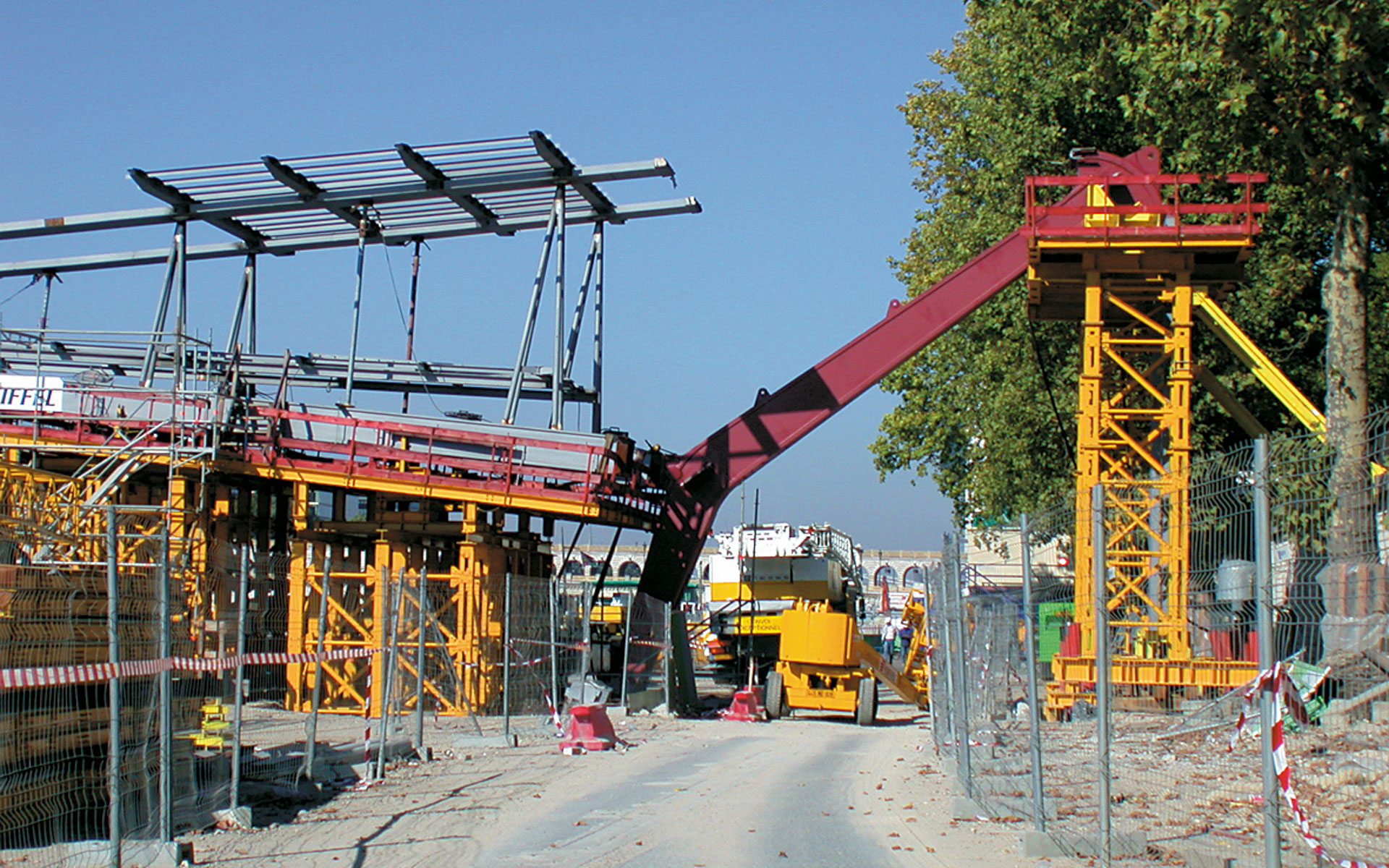

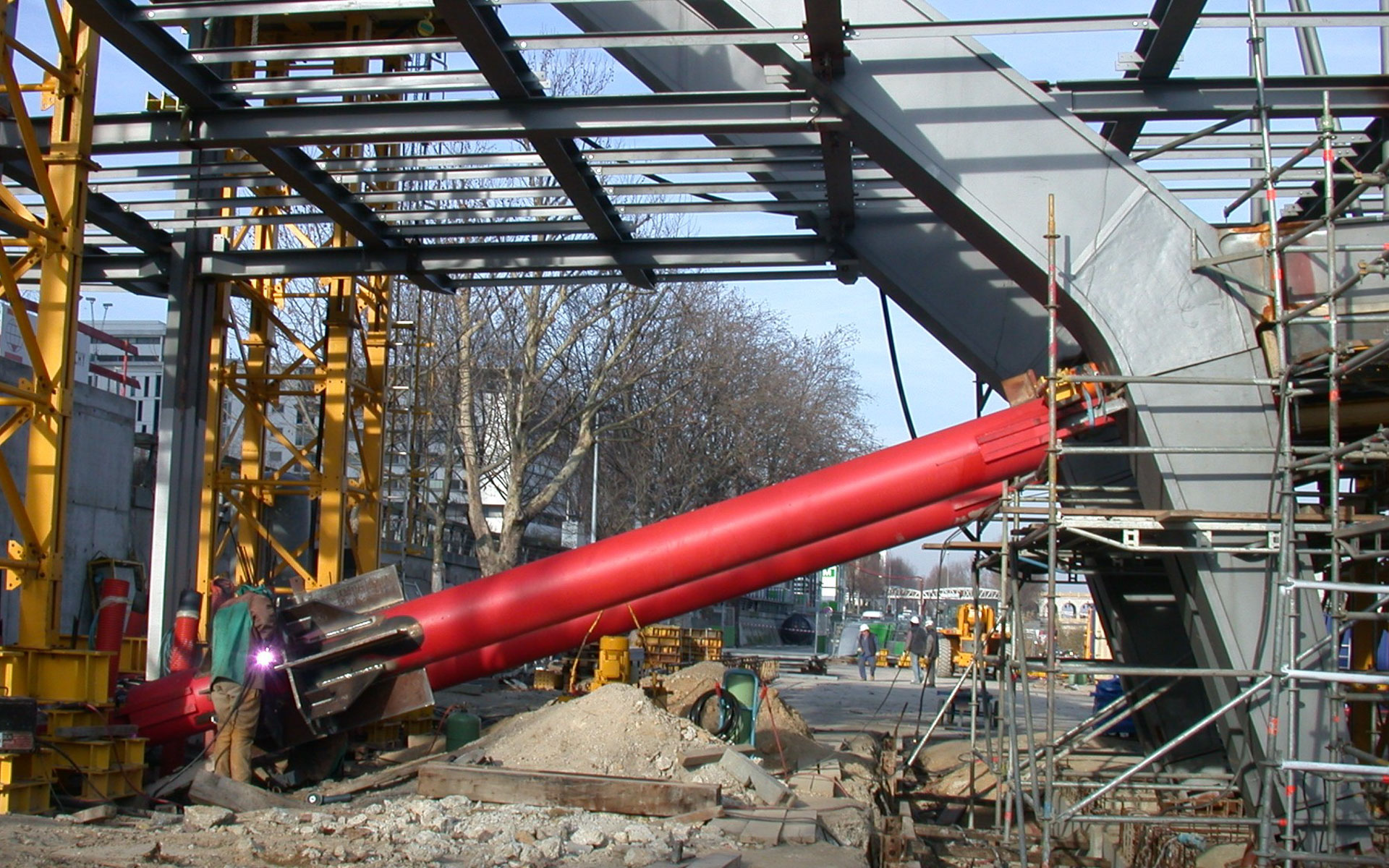



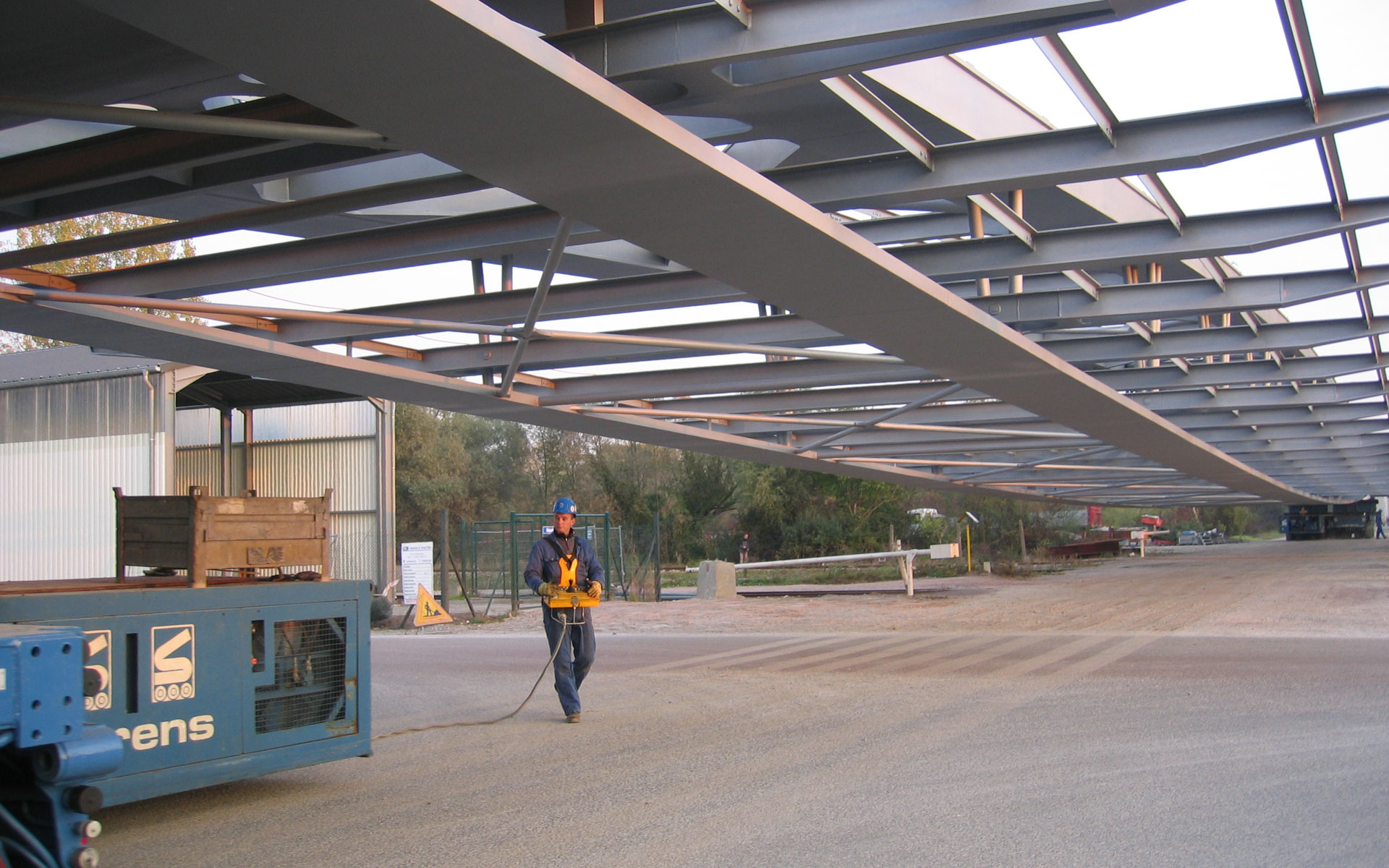



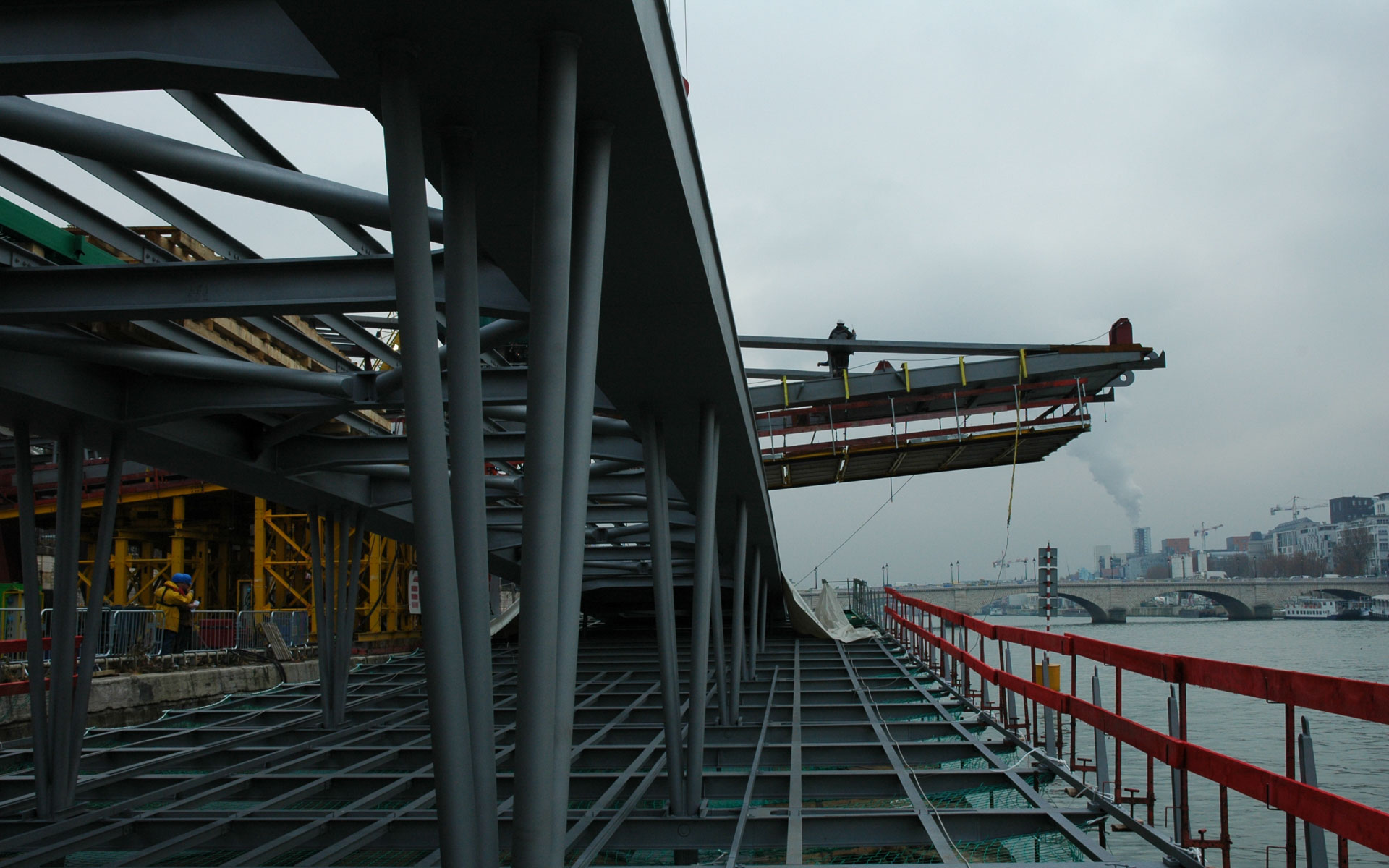

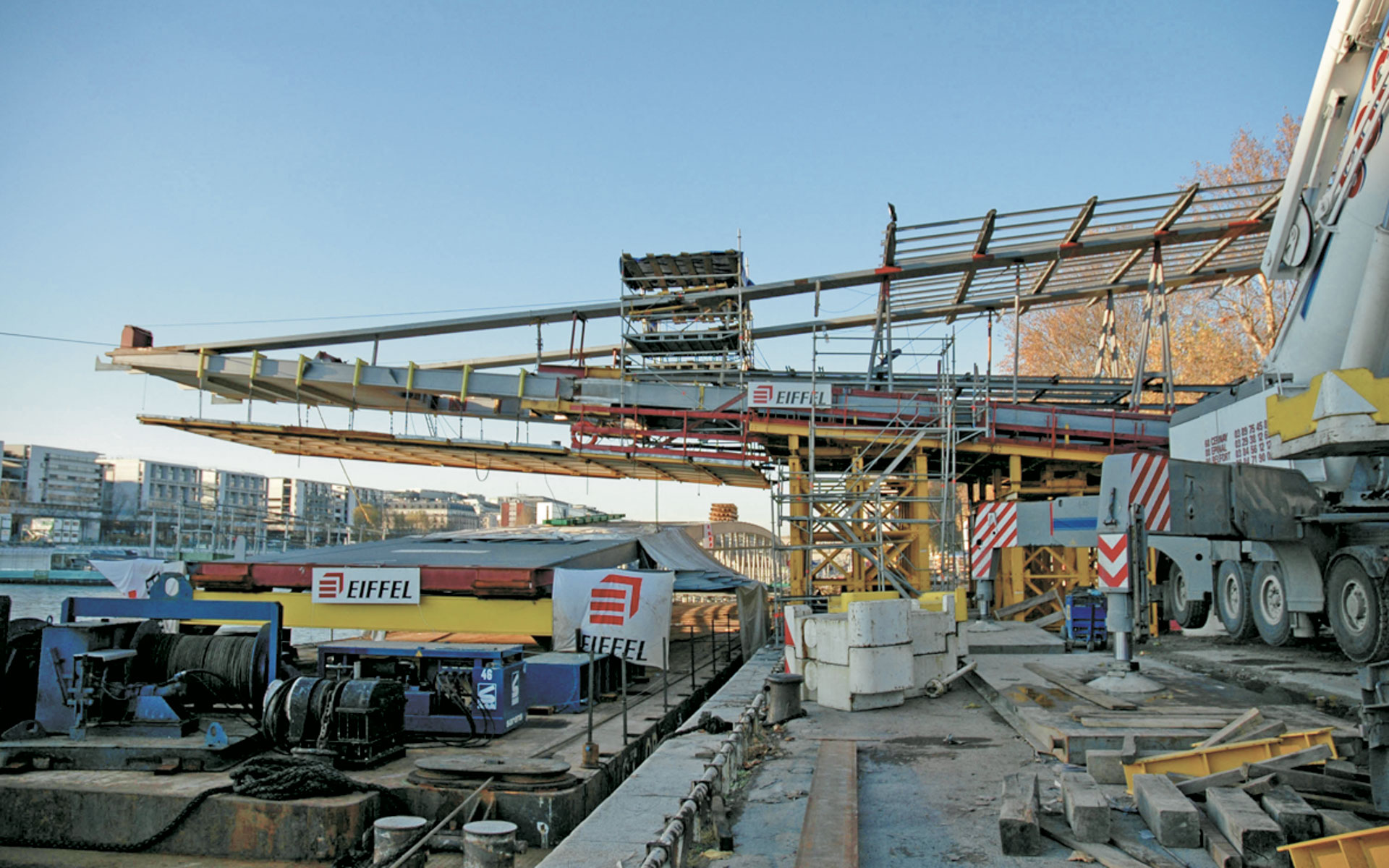






























































































































Simone-de-Beauvoir Footbridge
Paris |
France –
2006
Client
City of Paris
Start of construction
04 | 2004
Size
304 m
Construction budget
18.90 M€
Competition winner
1999
Completion
07 | 2006
DETAIL Award, Innovation Steel 2009
Footbridge Award, Category Aesthetics 2008
EUMies Award, 2007 nomination
European Steel Design Award 2007
ZT Award
Equerre d’Argent, Prix special 2006
One and many, by Jean-Paul Robert
The Simone de Beauvoir footbridge seems to float in the air, carried along by its own momentum, simply depending on its own audacity. Grace is conferred by its physical lightness and elegance by its apparent technical simplicity. It is an event in itself: those using it are less motivated by a need to cross the river than by the pleasure of being there to contemplate the river, the passing of time, and the new landscape that it reveals and arranges. Without it, the river Seine and its surrounds would now seem incomplete. It is one and many, formed by waves giving it a syncopated rhythm. It crosses over the riverside roadways to either side – on the right bank, a chaotic expanse and, on the left bank, a more organized avenue running below the steps leading up to the National Library. It rests on the river banks, relaxed and open on one side, restricted on the other, before its symmetrical launch, freed from its asymmetrical departure points. Over its 194 meters, an arch and a beam cross in the air above the water, each linking the two heights of the two banks: at the top, the National Library esplanade and garden terrace with, lower down, the two quaysides. Ramps and staircases lead to the river banks. The footbridge design is almost self-evident and the purity of its lines remains unencumbered. Approaching it provides a discovery of the amplitude of its bows. It seems to resemble a rope bridge, a gentle rollercoaster that invites pedestrians to cross the river. You can feel it vibrate. It is flexible rather than rigid and, if you stop in the middle, it seems to shiver underfoot. Its designer, Dietmar Feichtinger, wanted it to be a living entity. Over and above its personal style, the relevance of its architecture, the appropriateness of its location and its full controlled design, or perhaps thanks to all these assembled qualities, it provides a true lesson in philosophy that incites the viewer to appreciate it as a work of art rather than a feat of engineering.
The footbridge is a hub. Not just because, trivially, it links two river banks and two districts that until now had been separated, nor because it provides a new choice of routes to be take, but rather because it creates an equilibrium. Rather than being static, frozen or complete, it is an equilibrium that is dynamic inasmuch as it is in a state of constant change that depends on the loads, winds and temperature. Its elastic and flexible equilibrium is not the result of an established order governed by constraints demanding the use of excessive measures to hold it in position should there be an accumulation of loads. Rather than being like an oak tree, constrained and rigid, it is more like a reed, free, fluid and reactive. While it is clear that the footbridge uses few materials, those used assist one another, with traction compensating for compression and torque balancing torsion. The perfect solidarity of the elements, their shared workload and stresses offer a way of adapting to the world with its difficulties and adversities. The footbridge gives physical form to the flows developed for its design and resembles a suspended wave-like movement. There is no design affectation, no redundant details. The metal elements are welded together, nothing is bolted to the structure, with the exception of the oak floor planking. The footbridge is bare, empty. There are no cluttering benches or lighting columns. It is a setting to stroll, a place to let imagination roam free. It runs, stops, rebounds and flies. Its syncopations are those of time, of the relaxed breathing of the tightrope walker before he begins his exploit, when focus and relaxation ward off any dangers.
Lead Architect: Dietmar Feichtinger Architectes, mandate
Engineers: Rfr
Steel Work: Eiffel Constructions
Steel wok co-contractor: Joseph Paris SA
Co-contractor Special Foundations: Soletache Bachy
Dynamic Studies Execution Phase: Setac
Dynamic Tests Execution Phase: Cstb
Controller : Setra
Wind Tunnel Tests, Aerodynamic Tests: Psp Aachen, Dr. Hortmanns
Metalwork (railings, elevator tower): Snst
Electrical Lighting: Forclum
Elevators : Etna Fapel
Wood Decking: Cm Leduc
Painting: Borifer
Transport: Sarens
Cast Parts: Outreau
Footbridge Award, Category Aesthetics 2008
EUMies Award, 2007 nomination
European Steel Design Award 2007
ZT Award
Equerre d’Argent, Prix special 2006
One and many, by Jean-Paul Robert
The Simone de Beauvoir footbridge seems to float in the air, carried along by its own momentum, simply depending on its own audacity. Grace is conferred by its physical lightness and elegance by its apparent technical simplicity. It is an event in itself: those using it are less motivated by a need to cross the river than by the pleasure of being there to contemplate the river, the passing of time, and the new landscape that it reveals and arranges. Without it, the river Seine and its surrounds would now seem incomplete. It is one and many, formed by waves giving it a syncopated rhythm. It crosses over the riverside roadways to either side – on the right bank, a chaotic expanse and, on the left bank, a more organized avenue running below the steps leading up to the National Library. It rests on the river banks, relaxed and open on one side, restricted on the other, before its symmetrical launch, freed from its asymmetrical departure points. Over its 194 meters, an arch and a beam cross in the air above the water, each linking the two heights of the two banks: at the top, the National Library esplanade and garden terrace with, lower down, the two quaysides. Ramps and staircases lead to the river banks. The footbridge design is almost self-evident and the purity of its lines remains unencumbered. Approaching it provides a discovery of the amplitude of its bows. It seems to resemble a rope bridge, a gentle rollercoaster that invites pedestrians to cross the river. You can feel it vibrate. It is flexible rather than rigid and, if you stop in the middle, it seems to shiver underfoot. Its designer, Dietmar Feichtinger, wanted it to be a living entity. Over and above its personal style, the relevance of its architecture, the appropriateness of its location and its full controlled design, or perhaps thanks to all these assembled qualities, it provides a true lesson in philosophy that incites the viewer to appreciate it as a work of art rather than a feat of engineering.
The footbridge is a hub. Not just because, trivially, it links two river banks and two districts that until now had been separated, nor because it provides a new choice of routes to be take, but rather because it creates an equilibrium. Rather than being static, frozen or complete, it is an equilibrium that is dynamic inasmuch as it is in a state of constant change that depends on the loads, winds and temperature. Its elastic and flexible equilibrium is not the result of an established order governed by constraints demanding the use of excessive measures to hold it in position should there be an accumulation of loads. Rather than being like an oak tree, constrained and rigid, it is more like a reed, free, fluid and reactive. While it is clear that the footbridge uses few materials, those used assist one another, with traction compensating for compression and torque balancing torsion. The perfect solidarity of the elements, their shared workload and stresses offer a way of adapting to the world with its difficulties and adversities. The footbridge gives physical form to the flows developed for its design and resembles a suspended wave-like movement. There is no design affectation, no redundant details. The metal elements are welded together, nothing is bolted to the structure, with the exception of the oak floor planking. The footbridge is bare, empty. There are no cluttering benches or lighting columns. It is a setting to stroll, a place to let imagination roam free. It runs, stops, rebounds and flies. Its syncopations are those of time, of the relaxed breathing of the tightrope walker before he begins his exploit, when focus and relaxation ward off any dangers.
Lead Architect: Dietmar Feichtinger Architectes, mandate
Engineers: Rfr
Steel Work: Eiffel Constructions
Steel wok co-contractor: Joseph Paris SA
Co-contractor Special Foundations: Soletache Bachy
Dynamic Studies Execution Phase: Setac
Dynamic Tests Execution Phase: Cstb
Controller : Setra
Wind Tunnel Tests, Aerodynamic Tests: Psp Aachen, Dr. Hortmanns
Metalwork (railings, elevator tower): Snst
Electrical Lighting: Forclum
Elevators : Etna Fapel
Wood Decking: Cm Leduc
Painting: Borifer
Transport: Sarens
Cast Parts: Outreau


